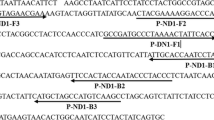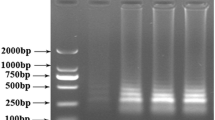Abstract
In this study, a simple and rapid high-throughput method for the detection of horse meat in processed food products is described. Specific loop-mediated isothermal amplification (LAMP) primers were designed to target the mitochondrial genome of horse (Equus caballus). No cross-reactions were observed for beef, pork, and chicken. Sensitivity tests showed reliable detection of 0.1 ng of extracted horse DNA. Spiking experiments were performed to show that the assay is capable of detecting 0.1 % horse meat in prepared model sausages, independent from their cooking time. Additionally, five different commercial horse meat products were analyzed to ensure the robustness of the assay when applied to varying food matrices. All experiments were performed on a heating block followed by visual detection using an intercalating dye. Results were confirmed by real-time fluorescence monitoring using a thermal cycler and compared to a previously published real-time PCR assay. In conclusion, this method is a good candidate for the simple and efficient testing of horse meat in food-products in the future.



Similar content being viewed by others
References
Abdulmawjood A, Grabowski N, Fohler S, Kittler S, Nagengast H, Klein G (2014) Development of loop-mediated isothermal amplification (LAMP) assay for rapid and sensitive identification of ostrich meat. PLoS One 9(6):1–6
Ahmed MU, Hasan Q, Hossain MM, Saito M, Tamiya E (2010) Meat species identification based on the loop mediated isothermal amplification and electrochemical DNA sensor. Food Control 21(5):599–605
Aliotta JM, Pelletier JJ, Ware JL, Moran LS, Brenner JS, Kong H (1996) Thermostable Bst DNA polymerase I lacks a 3’ → 5’ proofreading exonuclease activity. Genet Anal: Biomol Eng 12(5–6):185–195
Amani J, Kazemi R, Abbasi AR, Salmanian AH (2011) A simple and rapid leaf genomic DNA extraction method for polymerase chain reaction analysis. Iran J Biotechnol 9(1):69–71
Bowen HJM (1963) The elementary composition of mammalian blood. Wantage, Berkshire, United Kingdom
European Commission (2010) Off J Eur Union 15:1
European Commission (2013) Off J Eur Union 48:1
Iwamoto T, Sonobe T, Hayashi K (2003) Loop-mediated isothermal amplification for direct detection Mycobacterium tuberculosis Complex, M. avium, and M. intracellulare in Sputum Samples. J Clin Microbiol 41(6):2616–2622
Kaneko H, Kawana T, Fukushima E, Suzutani T (2007) Tolerance of loop-mediated isothermal amplification to a culture medium and biological substances. J Biochem Biophys Methods 70:499–501
Kitano T, Umetsu K, Tian W, Osawa M (2007) Two universal primer sets for species identification among vertebrates. Int J Legal Med 121:423–427
Köppel R, Ruf J, Zimmerli F, Breitenmoser A (2008) Multiple real-time PCR for the detection and quantification of DNA from beef, pork, chicken and turkey. Eur Food Res Technol 227:1199–1203
Köppel R, Zimmerli F, Breitenmoser A (2009) Heptaplex real-time PCR for the identification and quantification of DNA from beef, pork, chicken, turkey, horse meat, sheep (mutton) and goat. Eur Food Res Technol 230:125–133
Lee D, La Mura M, Allnutt TR, Powell W (2009) Detection of genetically modified organisms (GMOs) using isothermal amplification of target DNA sequences. BMC Biotechnol 9:7
Monis PT, Giglio S, Saint CP (2005) Comparison of SYTO9 and SYBR Green I for real-time polymerase chain reaction and investigation of the effect of dye concetration on amplification and DNA melting curve analysis. Anal Biochem 340(1):24–34
Nagamine K, Hase T, Notomi T (2002) Accelerated reaction by loop-mediated isothermal amplification using loop primers. Mol Cell Probes 16:223–229
Notomi T, Okayama H, Masubuchi H, Yonekawa T, Watanabe K (2000) Loop-mediated isothermal amplification of DNA. Nucleic Acids Res 28(12):I–VII
Walker MJ, Burns M, Burns DT (2013) Horse meat in beef products—species substitution 2013. J Assoc Publ Anal 41:67–106
Yamazaki W, Ishibashi M, Kawahara R, Inoue K (2008) Development of a loop-mediated isothermal amplification assay for sensitive and rapid detection of Vibrio parahaemolyticus. BMC Microbiol 8:163
Zahradnik C, Martzy R, Mach RL, Krska R, Farnleitner AH, Brunner K (2014a) Detection of the food allergen celery via loop-mediated isothermal amplification technique. Anal Bioanal Chem 406(27):6827–6833
Zahradnik C, Kolm C, Martzy R, Mach RL, Krska R, Farnleitner AH, Brunner K (2014b) Detection of the P35S promotor in transgenic maize via various isothermal amplification techniques: a practical approach. Anal Bioanal Chem [Epub ahead of print]
Acknowledgments
This work was financially supported by the Federal Country Lower Austria in cooperation with the European Regional Development Fund (ERDF).
Conflict of interest
Celine Zahradnik declares that she has no conflict of interest. Roland Martzy declares that he has no conflict of interest. Robert L. Mach declares that he has no conflict of interest. Rudolf Krska declares that he has no conflict of interest. Andreas H. Farnleitner declares that he has no conflict of interest. Kurt Brunner declares that he has no conflict of interest.
Compliance with Ethics Requirements
This article does not contain any studies with human or animal subjects.
Author information
Authors and Affiliations
Corresponding author
Electronic supplementary material
Below is the link to the electronic supplementary material.
Table S1
The presence of amplifyable DNA was proven via real-time PCR using a universal primer set for vertebrates targeting parts of the 12S rRNA, as previously published (Kitano et al. 2007), n = 10. (DOC 11 kb)
Figure S1
Agarose gel electrophoresis of the amplification products, resulting in a pattern typical for the various-sized LAMP products. Lane 1-10 - horse meat [10 ng/μL], lanes 11-15 - beef [10 ng/μL], lanes 16-20 - non-template control (NTC). (DOC 255 kb)
Rights and permissions
About this article
Cite this article
Zahradnik, C., Martzy, R., Mach, R.L. et al. Loop-Mediated Isothermal Amplification (LAMP) for the Detection of Horse Meat in Meat and Processed Meat Products. Food Anal. Methods 8, 1576–1581 (2015). https://doi.org/10.1007/s12161-014-0072-8
Received:
Accepted:
Published:
Issue Date:
DOI: https://doi.org/10.1007/s12161-014-0072-8




